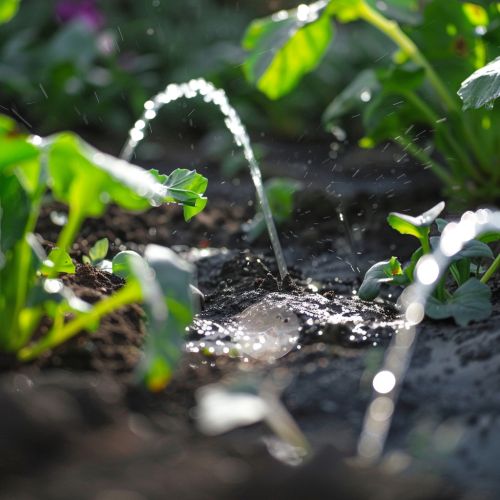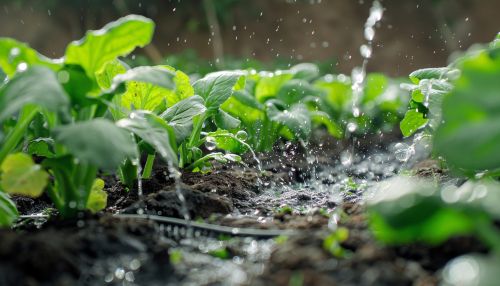Bubbler irrigation
Introduction
Bubbler irrigation, also known as micro-basin irrigation, is a precise and efficient method of delivering water directly to the root zone of plants. This irrigation technique is particularly beneficial in arid and semi-arid regions where water conservation is paramount. Bubbler irrigation systems are designed to release water at a slow, controlled rate, minimizing evaporation and runoff. This article delves into the technical aspects, benefits, and applications of bubbler irrigation, providing a comprehensive understanding of this advanced agricultural practice.
History and Development
The concept of bubbler irrigation emerged in the mid-20th century as a response to the need for more efficient water use in agriculture. Traditional irrigation methods, such as flood and furrow irrigation, were often wasteful and led to significant water loss through evaporation and runoff. The development of bubbler irrigation was driven by advancements in irrigation technology and a growing awareness of water scarcity issues.
Early bubbler systems were rudimentary, consisting of simple perforated pipes or hoses. Over time, technological advancements led to the development of more sophisticated systems with adjustable flow rates and pressure regulation. Today, bubbler irrigation systems are highly efficient and can be customized to meet the specific needs of different crops and soil types.
Components of Bubbler Irrigation Systems
Bubbler irrigation systems consist of several key components that work together to deliver water efficiently to plants. These components include:
Water Source
The water source for a bubbler irrigation system can be a well, reservoir, or municipal water supply. The quality of the water is crucial, as impurities can clog the emitters and reduce the system's efficiency.
Pump
A pump is used to pressurize the water and deliver it to the irrigation system. The type and size of the pump depend on the system's design and the area to be irrigated.
Mainline and Sub-mainline Pipes
The mainline pipe carries water from the pump to the sub-mainline pipes, which distribute water to different sections of the field. These pipes are typically made of durable materials such as PVC or polyethylene.
Emitters
Emitters, also known as bubblers, are the key components of the system. They release water at a controlled rate, ensuring that it reaches the root zone of the plants. Emitters can be adjustable or fixed, depending on the system's design.
Pressure Regulators
Pressure regulators are used to maintain a consistent water pressure throughout the system. This is important to ensure that all emitters deliver water at the same rate.
Filters
Filters are essential to prevent debris and impurities from clogging the emitters. Common types of filters used in bubbler irrigation systems include screen filters and disc filters.
Control Valves
Control valves are used to regulate the flow of water to different sections of the field. They can be manually operated or automated, depending on the system's complexity.


Design and Installation
Designing and installing a bubbler irrigation system requires careful planning and consideration of various factors, including soil type, crop requirements, and water availability. The following steps outline the general process:
Site Assessment
A thorough site assessment is the first step in designing a bubbler irrigation system. This involves analyzing the soil type, topography, and water source. Soil tests are conducted to determine the soil's infiltration rate, water-holding capacity, and nutrient content.
System Layout
The system layout involves mapping out the mainline and sub-mainline pipes, emitters, and control valves. The layout should be designed to ensure uniform water distribution and minimize water loss.
Component Selection
Selecting the right components is crucial for the system's efficiency. This includes choosing the appropriate pump, pipes, emitters, pressure regulators, and filters. The components should be compatible with each other and suitable for the specific conditions of the site.
Installation
The installation process involves laying the mainline and sub-mainline pipes, installing the emitters and control valves, and connecting the system to the water source. Proper installation techniques are essential to prevent leaks and ensure the system's longevity.
Testing and Calibration
Once the system is installed, it must be tested and calibrated to ensure that it operates correctly. This involves checking for leaks, adjusting the emitters' flow rates, and ensuring that the water pressure is consistent throughout the system.
Advantages of Bubbler Irrigation
Bubbler irrigation offers several advantages over traditional irrigation methods, making it an attractive option for farmers and gardeners. These advantages include:
Water Efficiency
Bubbler irrigation systems are highly efficient in terms of water use. By delivering water directly to the root zone, these systems minimize evaporation and runoff, reducing water waste.
Improved Plant Health
By providing a consistent and controlled water supply, bubbler irrigation promotes healthy root development and reduces the risk of water stress. This leads to healthier plants and higher crop yields.
Reduced Labor Costs
Bubbler irrigation systems can be automated, reducing the need for manual labor. This is particularly beneficial for large-scale agricultural operations.
Flexibility
Bubbler irrigation systems can be customized to meet the specific needs of different crops and soil types. This flexibility makes them suitable for a wide range of agricultural applications.
Environmental Benefits
By reducing water waste and promoting efficient water use, bubbler irrigation systems help conserve water resources and protect the environment.
Applications of Bubbler Irrigation
Bubbler irrigation is used in various agricultural and horticultural applications, including:
Row Crops
Bubbler irrigation is commonly used for row crops such as vegetables, fruits, and grains. The precise water delivery ensures that each plant receives the optimal amount of water, promoting healthy growth and high yields.
Orchards and Vineyards
In orchards and vineyards, bubbler irrigation systems are used to provide water directly to the root zones of trees and vines. This helps maintain soil moisture levels and supports healthy root development.
Landscape Irrigation
Bubbler irrigation is also used in landscape irrigation for gardens, lawns, and parks. The controlled water delivery helps maintain healthy plants and reduces water waste.
Greenhouses
In greenhouses, bubbler irrigation systems provide a consistent and controlled water supply to plants, ensuring optimal growing conditions.
Challenges and Limitations
Despite its many advantages, bubbler irrigation also has some challenges and limitations:
Initial Cost
The initial cost of installing a bubbler irrigation system can be high, particularly for large-scale operations. However, the long-term savings in water and labor costs can offset this initial investment.
Maintenance
Bubbler irrigation systems require regular maintenance to ensure that they operate efficiently. This includes checking for leaks, cleaning filters, and adjusting emitters.
Water Quality
The quality of the water used in bubbler irrigation systems is crucial. Impurities and debris can clog the emitters and reduce the system's efficiency. Regular filtration and water quality monitoring are essential.
Soil Compatibility
Bubbler irrigation may not be suitable for all soil types. Soils with low infiltration rates or poor drainage may not benefit from this irrigation method. A thorough site assessment is necessary to determine the suitability of bubbler irrigation for a specific location.
Future Trends and Innovations
The field of bubbler irrigation is continuously evolving, with new technologies and innovations being developed to improve efficiency and performance. Some of the emerging trends and innovations include:
Smart Irrigation Systems
Smart irrigation systems use sensors and automated controls to optimize water delivery based on real-time data. These systems can adjust the flow rates and timing of irrigation based on soil moisture levels, weather conditions, and plant needs.
Advanced Emitters
New designs and materials for emitters are being developed to improve their durability and performance. These advanced emitters can deliver water more precisely and are less prone to clogging.
Integrated Fertigation
Fertigation, the application of fertilizers through the irrigation system, is becoming increasingly popular. Integrated fertigation systems allow farmers to deliver nutrients directly to the root zone, improving nutrient uptake and reducing fertilizer waste.
Sustainable Practices
There is a growing emphasis on sustainable irrigation practices that minimize environmental impact. This includes the use of renewable energy sources for pumping water and the adoption of water-saving technologies.
Conclusion
Bubbler irrigation is a highly efficient and effective method of delivering water to plants. By providing a controlled and consistent water supply directly to the root zone, this irrigation technique promotes healthy plant growth, conserves water, and reduces labor costs. While there are some challenges and limitations, the benefits of bubbler irrigation make it a valuable tool for modern agriculture and horticulture. As technology continues to advance, the future of bubbler irrigation looks promising, with new innovations and sustainable practices enhancing its efficiency and performance.
